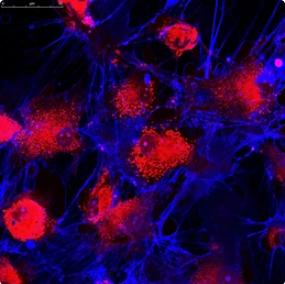Introduction of Texas Red
Texas Red is a red-emitting dye used in various applications such as fluorescence microscopy, flow cytometry, and molecular biology. It belongs to the class of sulfonated xanthene dyes and is commonly used as a fluorescent label in biological research. Texas Red has excitation and emission wavelengths around 595 nm and 615 nm, respectively. Due to its bright signal and photostability, Texas Red is widely utilized in labeling antibodies, nucleic acids, proteins, and other biomolecules for detection and imaging purposes. Its use can be found in immunofluorescence staining, cell analysis, and various labeling techniques for visualization and quantification of biological samples.

Product List
Click the product name to view product details.
Characteristics of Texas Red Dye
- Fluorescent properties: Texas Red exhibits strong fluorescence in the red spectrum range. It is commonly used in imaging techniques such as fluorescence microscopy and flow cytometry.

- Stability: Texas Red dye is known for its stability, making it a reliable choice for long-term experiments or storage. It is resistant to photobleaching, allowing for prolonged fluorescence detection.
- Versatility: Texas Red dye can be conjugated to various biomolecules such as antibodies, proteins, nucleic acids, and small molecules. This versatility enables its use in a wide range of applications, including immunofluorescence staining, cell labeling, and nucleic acid detection.
- Solubility: Texas Red dye is typically soluble in polar solvents like water and common buffers, allowing for easy preparation of dye conjugates or staining solutions.
- Absorption and emission spectra: Texas Red dye has well-defined absorption and emission spectra, which facilitates multiplexing with other fluorophores for multicolor imaging and detection assays.
Applications of Texas Red
Texas Red is a red-fluorescent dye commonly used in molecular and cell biology research for various applications. Some common applications of Texas Red include:
- Immunofluorescence: Texas Red-labeled antibodies are used in immunofluorescence assays to detect the presence and localization of specific proteins in cells or tissues. The bright red fluorescence emitted by Texas Red allows for visualization and analysis of target molecules in biological samples.
- Cell labeling and tracking: Cells can be labeled and tracked in vitro and in vivo using Texas Red. The dye can be incorporated into cell membranes or cell structures to study cell migration, proliferation, and differentiation.
- Fluorescence in situ hybridization (FISH): Texas Red can be utilized in FISH techniques to detect and visualize specific DNA sequences in chromosomes. The dye is used in conjunction with nucleic acid probes to study gene expression, genomic rearrangements, and chromosomal abnormalities.
- Live-cell imaging: Texas Red is suitable for live-cell imaging experiments to monitor cellular processes in real-time. The dye can be employed to study dynamic events such as cell signaling, membrane trafficking, and organelle movement within living cells.
- Flow cytometry: Texas Red is utilized in flow cytometry analyses to label and quantify cells based on specific surface markers or intracellular proteins. The dye enables the identification and sorting of cell populations for downstream molecular and functional studies.
- Localization studies: Texas Red-labeled biomolecules, such as proteins and nucleic acids, are employed to investigate their subcellular localization and trafficking pathways. The dye allows for the visualization of molecular interactions and cellular structures.
Overall, Texas Red is a versatile fluorescent dye extensively used in biological research for labeling, imaging, and analyzing various cellular components and processes.



